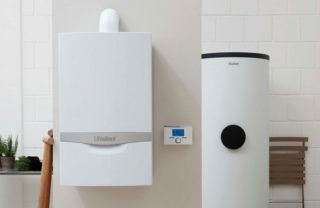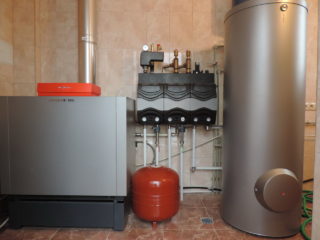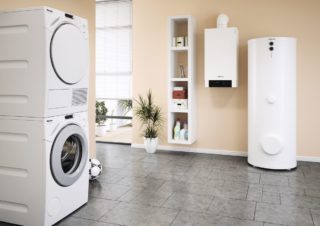In this article, we will analyze the issues related to heating of a home by the people, blue fuel. After reading the article to the end, you decide for yourself to heat with gas or not. Having made a decision in favor of gas equipment, we will help you step by step to determine the choice of equipment.
Pros and cons of heating gas boilers
 Main advantages gas heating before other types of fuel will be:
Main advantages gas heating before other types of fuel will be:
- The low cost of a kilowatt of thermal energy, the communal payment for the meter does not greatly upset the owners of the houses (if we are talking about main gas).
- High efficiency over 90% according to the boiler passport.
- Simple operation (no need to maintain weekly, when compared with solid fuel boilers).
- High boiler power over 30 kW (when compared with electric heating, the maximum allocated power to the house, 15 kW at a voltage of 380 V).
The main disadvantages gas heating are:
- Difficulties in obtaining permits for connecting the house to the gas main.
- A considerable amount will have to be paid for a tie-in to the gas main (for example, 2150000 were counted for connecting to GORGAZ, 200 meters to the main, a house in the Moscow region).
- Explosion of gas (if the installation is carried out without observing the standards, if the equipment is not used correctly).
The contract for the maintenance of gas equipment, according to the new law, is concluded with the owners of houses who use a gas boiler for heating the house (Decree of the Government of the Russian Federation No. 410 was adopted on May 14, 2013, if the owner refuses to enter into an agreement, service organizations have the right to stop the supply of gas to a house or apartment legally). You will not frighten our person with the possibility of terminating the supply, therefore they adopted a new law of December 5, 2016, now they will be fined for the lack of an agreement. Maintenance costs money, which will be additional, in addition to the cost of gas, a blow to the owner’s wallet.
What gas to heat the house
 There are two types of gaseous fuel in Russia:
There are two types of gaseous fuel in Russia:
- Main methane gas. If a yellow pipe from the central gas pipeline is brought to the house.
- Liquefied petroleum gas (LPG) the most common type of mixture is propane and butane.
Heating a house with liquefied gas requires a number of features to be taken into account:
- To transfer the gas boiler to the propane-butane mixture, the nozzles for the gas supply to the combustion chamber of the boiler are changed. Adjust the gas pressure in the boiler according to the weight gauge.
- Set in the yard, underground, a gas holder for gas. We recommend taking a larger volume, for example, not 2.5 cubic meters, but 3.5 cubic meters. The price difference between the two gas holders is small, but installing a larger gas tank will get the following advantages. Gas will not end in the middle of winter and you will not have to quickly look for who will arrive and refuel the gas holder in the cold. We recommend refueling a large gas tank in the spring at the beginning of the season, when LPG prices are minimal. Another option for storing LPG is a “mobile gas tank”. It is a cylinder with a volume of 600 liters on a car trailer, according to the law it is allowed to tow up to 600 liters of LPG on public roads without permits.
- If the heated area is up to 100 sq.m, then gas cylinders are used by connecting them to the boiler through a ramp. A good alternative to traditional, red steel cylinders are composite cylinders. They make composite cylinders in Europe. They are much lighter than metal counterparts and safer to operate, thanks to a plastic casing and an integrated emergency pressure relief valve.
Gas boiler selection
 The first thing to do is to choose the power of the boiler. To do this, perform the heat engineering calculation of your home. Having learned how many kilowatts per hour the house is losing, you can understand how much boiler power is needed to compensate for heat loss. If we plan to use the boiler in addition to heating for the preparation of hot water, it is also necessary to take this into account when choosing the power of the boiler.
The first thing to do is to choose the power of the boiler. To do this, perform the heat engineering calculation of your home. Having learned how many kilowatts per hour the house is losing, you can understand how much boiler power is needed to compensate for heat loss. If we plan to use the boiler in addition to heating for the preparation of hot water, it is also necessary to take this into account when choosing the power of the boiler.
Next, you can determine which version of the boiler suits you, floor or wall. It is advisable to install floor-standing boilers if the heat loss at home and the loss in the preparation of hot water are more than 30 kW. Floor-mounted boiler heat exchangers are made of cast iron, which lasts longer than the wall-mounted boiler heat exchanger. The service life of the floor boiler is 20 years or more. For a floor boiler, due to its heavy weight, a foundation device is required. The cast iron from which the heat exchanger is made is brittle and does not like temperature changes between direct and reverse water supply to the boiler. To protect the heat exchanger from destruction during temperature extremes, it is necessary to put a hydraulic arrow after the boiler.
If the boiler power is less than 30 kW, then choose a wall-mounted boiler.
When choosing a wall-mounted boiler, we decide what type of heating will be in the house: mainly floor or radiator. If you chose the floor, we recommend paying attention to condensing boilers. Compared with conventional efficiency is higher due to the use of heat of the exhaust gases. The condensing boiler is optimal for working with low-temperature heating systems, such as underfloor heating. But the boiler has a significant drawback, it is the utilization of acid generated during the operation of the boiler, which cannot be drained directly into the sewer.
Also, when choosing a wall-mounted boiler, it is necessary to decide which boiler to take with an open or closed combustion chamber. For a closed combustion chamber, a coaxial chimney is required, which is convenient to install, just make a hole in the wall with a crown and bring the chimney out into the street. For a boiler with an open chamber, it is necessary to connect a chimney with natural draft with the exit of the pipe to the roof, plus a sufficient amount of air must enter the boiler room to maintain normal combustion.


